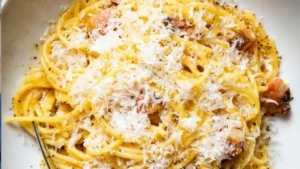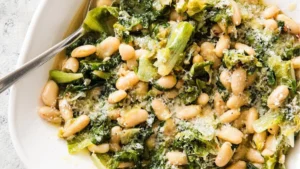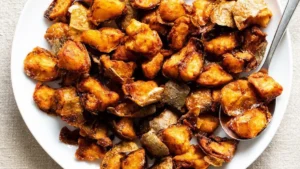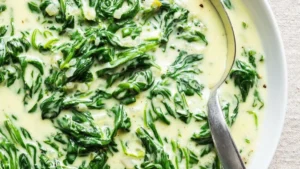The Perfect Balance of Flavors
Spaghetti carbonara is a beloved Roman dish that has been interpreted in various ways by cooks all over the world. However, today we will explore a more authentic version of this classic dish. In this recipe, every ingredient plays a crucial role in creating a creamy and rich sauce. Let’s dive in!
Ingredients
- 1 pound of spaghetti
- 4 quarts of boiling water
- 1 tablespoon of salt
- Italian pork jowls (guanciale) or pancetta (as a substitute)
- 2 tablespoons of extra virgin olive oil
- 3 whole eggs
- 2 egg yolks
- 2.5 ounces of pecorino romano cheese (or Parmesan as a substitute)
- 1/4 teaspoon of salt
- 1 teaspoon of fresh cracked black pepper
Instructions
Before we start, make sure to have all your ingredients ready, as this recipe moves quite quickly.
Cooking the Spaghetti
Begin by cooking the spaghetti in four quarts of boiling water with one tablespoon of salt. Cook until the spaghetti is al dente.
Preparing the Guanciale
If using guanciale, cut it into half-inch pieces. If using pancetta, cut it into similar-sized pieces as the guanciale. Cook the guanciale or pancetta in a non-stick skillet with two tablespoons of extra virgin olive oil over medium heat. Cook until the fat from the guanciale is rendered and the pork is just shy of crisp, about six minutes.
Creating the Sauce
In a bowl, whisk together three whole eggs and two additional egg yolks. Add the pecorino romano cheese, finely grated, and mix until well combined. Season the mixture with 1/4 teaspoon of salt and one teaspoon of fresh cracked black pepper.
Combining the Ingredients
Once the spaghetti is cooked, reserve half a cup of the pasta-cooking water. Drain the spaghetti and return it to the pot. Add the rendered fat from the guanciale or pancetta, along with the cooked pork. Mix well to ensure the guanciale fat coats the pasta.
Next, temper the eggs by gradually adding a quarter cup of the reserved pasta-cooking water to the egg mixture while whisking continuously. Pour the egg mixture into the pot with the spaghetti and stir with tongs for one to two minutes, until the sauce becomes creamy. Adjust the consistency of the sauce by adding more pasta-cooking water if needed.
Serving the Spaghetti Carbonara
To serve, divide the spaghetti carbonara into bowls and garnish with additional cracked black pepper, if desired. The carbonara pairs well with a sprinkle of grated pecorino romano cheese. Enjoy!
Conclusion
By following this authentic recipe, you can create a delicious and creamy spaghetti carbonara that rivals the ones found in Rome. The careful balance of ingredients, from the guanciale to the eggs to the cheese, ensures that every bite is full of flavor. Don’t forget to serve it with a side of crusty bread to soak up the extra sauce. Buon appetito!
Demystifying Egg Carton Labels
Understanding the Terminology
Egg carton labels can be confusing, with various terms and claims. Let’s break down some of the common labels you may come across at the supermarket.
Grade A Eggs
All eggs sold in supermarkets are Grade A eggs, indicating that they meet the highest quality standards set by the USDA. These eggs are fresh and hormone-free.
Egg Color
While eggs come in different colors, such as white, brown, or seafoam, the color does not affect their nutritional value or flavor. It is purely an aesthetic difference.
Pasteurized Eggs
Pasteurized eggs undergo a process that kills any potential bacteria, making them safe to use in raw applications like Caesar salad dressing. However, pasteurized eggs may not whip as well for recipes like soufflés.
Organic Eggs
Organic eggs are regulated by the USDA and ensure that the hens are fed an organic diet and have access to the outdoors. Look for the USDA Organic seal on the carton.
Certified Humane Eggs
Certified Humane eggs are regulated by third-party organizations and indicate that the hens are raised in warehouses with specific animal welfare guidelines in place. These guidelines may include restrictions on practices like debeaking.
Cage-Free Eggs
Cage-free eggs mean that the hens are not raised in cages but are still kept indoors in a warehouse environment.
Free-Range Eggs
Free-range eggs, regulated by the USDA, indicate that the hens have continuous access to the outdoors. While they may not spend all their time outside, they have the opportunity to forage for food.
Storage and Shelf Life
In the United States, it is recommended to refrigerate eggs because they are washed, which removes the protective cuticle on the shell. Refrigerating eggs helps prevent bacteria from entering the egg. In Europe, where eggs are typically unwashed, they can be stored at room temperature.
Expiration Dates
The USDA suggests consuming eggs within three to five weeks of purchase. However, eggs can often be fine for up to two or three months when stored properly. Keep in mind that the quality of the whites may deteriorate over time, affecting their ability to whip well.
Conclusion
Understanding egg carton labels is essential for making informed choices at the supermarket. While color and certain claims may be important to some consumers, the primary focus should be on the quality and freshness of the eggs. By following proper storage guidelines, you can enjoy delicious and nutritious eggs in your favorite recipes.
Ancient Potato-Preserving Techniques and Instant Mashed Potato Gnocchi
Preserving Potatoes the Inca Way
The Incas, in the high Andes mountains, developed a unique method of preserving potatoes. They would freeze the potatoes overnight and then dry them under the sun. These freeze-dried potatoes, known as chuño, are still a popular traditional food today.
Instant Mashed Potatoes: A Convenient Pantry Staple
In the 1950s, the R.T. French company introduced instant mashed potatoes as a convenient alternative to traditional potato preparation. These flakes, made from dehydrated potatoes, can be reconstituted with liquid, offering a quick and versatile ingredient for various recipes.
Instant Mashed Potato Gnocchi al Forno
Gnocchi, a beloved Italian dish, is known for its time-consuming preparation. However, with the help of instant mashed potato flakes, you can enjoy homemade gnocchi in a fraction of the time.
Ingredients
- 2 cups of instant mashed potato flakes (plain, without flavorings)
- 1 cup of all-purpose flour
- 2 teaspoons of table salt
- 1.5 cups of water
- 1 egg
- Tomato sauce (marinara) for serving
Instructions
With the help of instant mashed potato flakes, making gnocchi becomes a breeze. Here’s how to do it:
Mixing the Dough
In a bowl, whisk together two cups of instant mashed potato flakes, one cup of all-purpose flour, and two teaspoons of table salt. In a separate bowl, combine 1.5 cups of water and one egg. Gradually add the liquid mixture to the dry ingredients, stirring until a dough forms.
Kneading the Dough
Knead the dough for a few minutes until it becomes elastic and slightly springy. This step helps develop gluten, ensuring the gnocchi has structure and a satisfying texture.
Shaping the Gnocchi
Divide the dough into six equal pieces. Working with one piece at a time, roll it into a rope about 3/4 of an inch in diameter. Cut the rope into 3/4-inch pieces and shape each piece by rolling it over the tines of a fork to create ridges. Place the shaped gnocchi on a well-floured baking sheet.
Cooking and Serving
Bring a pot of salted water to a boil. Cook the gnocchi in batches for about one and a half minutes, or until they float to the surface. Use a slotted spoon or skimmer to transfer the cooked gnocchi to a serving dish. Serve with your favorite tomato sauce (marinara) and enjoy!
Conclusion
Thanks to the convenience of instant mashed potato flakes, you can enjoy homemade gnocchi without spending hours in the kitchen. The gnocchi’s pillowy texture pairs perfectly with a flavorful tomato sauce, making it a delightful and satisfying meal. Don’t forget to top it off with some grated Parmesan cheese for extra flavor. Buon appetito!









